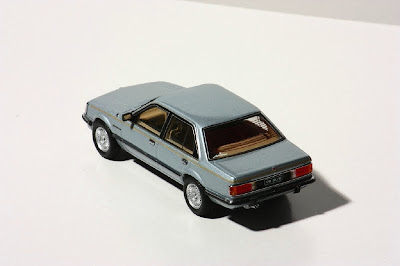Introduced in October 1978, the Holden VB Commodore development covered a period with the effects of the 1973 oil crisis still being felt. Hence, when Holden decided to replace the successful full-size HZ Kingswood with a new model line, they designed the new car to be smaller and more fuel efficient. Originally, Holden looked at developing a new WA Kingswood, however, this project was later dismissed. With no replacement in development, Holden looked towards Opel for providing the foundations of the VB, basing it loosely on the four-cylinder Rekord E bodyshell with the front grafted on from the Opel Senator A. This change was necessitated to accommodate the larger Holden six- and eight-cylinder engines. Holden also adopted the name "Commodore" from Opel, which had been using the name since 1967. Opel went on to use Holden’s Rekord-Senator hybrid as a foundation for its new generation Commodore C, slotting in between the two donor models.
Using GM’s rear-wheel drive V-body platform as used by the Rekord and Senator, the VB retained 96 percent of the preceding HZ Kingswood's interior space, despite being14 percent smaller in overall dimensions, although five percent larger than the Torana.
With the Commodore dropping a full class below the Kingswood and its Ford Falcon competitor, the smaller Commodore was predictably more fuel-efficient. This downsizing was first seen as a major disadvantage for Holden, as they had effectively relinquished the potential of selling Commodores to the fleet and taxi industries. These sales losses were thought to be unrecoverable; however, the 1979 energy crisis saw Australian oil prices rise by 140 percent, putting substantial strain on the automotive industry to collectively downsize, a change that Holden had already done.
During the VB’s development, Holden realised that when driven at speed over harsh Australian roads, the Rekord would effectively break in half at the firewall. This forced Holden to rework the entire car for local conditions, resulting in only 35 percent commonality with the Opel. The Rekord’s MacPherson strut front suspension was accordingly modified, and the recirculating ball steering was replaced with a rack and pinion type. These modifications blew development costs beyond expectations to a reported A$110 million—a figure close to the cost of developing a new model independently. With such a large sum consumed by the VB development programme, Holden was left with insufficient finances to resource the development of a wagon variant. Added that the Commodore architecture was considered an unsuitable base for utility and long-wheelbase models, Holden was left with only a sedan, albeit one in three levels of luxury: a base, SL, and SL/E. Desperate measures forced Holden to shape the Commodore front-end to the rear of the Rekord wagon. As the wagon-specific sheet metal had to be imported from Germany, the wagon, introduced in July 1979, suffered from inevitable component differences from the sedan. Although infrequently criticised in the early years, quality problems were evident, with poor trim and panel fit problematic for all first generation Commodores. This coupled with mechanical dilemmas such as water pump failure and steering rack rattle ensured warranty claims were high in the first year. In face of these issues, VB was praised for its value for money and sophistication, especially in regards to the steering, ride quality, handling and brakes, thus securing the Wheels Car of the Year award for 1978.
The most significant change to the VC Commodore of March 1980 was the engine upgrading to "XT5" specification. Now painted blue and thus known as the Blue straightsixes and Holden V8s, these replaced the Red units fitted to the VB and earlier cars. Changes included a new twelve-port cylinder head, re-designed combustion chambers,inlet and exhaust manifolds, a new two-barrel carburettor and a Bosch electronic ignition system for the inline sixes. Tweaks and changes to the V8s surrounded the implementation of electronic ignition, revised cylinder head and inlet manifold design and the fitment of a four-barrel carburettor on the 4.2-litre variant. These changes brought improved efficiency, increased outputs and aided driveability. In response to increasing oil prices, a four-cylinder variant was spawned in June 1980. Displacing 1.9-litres, this powerplant known as Starfire was effectively Holden's existing straight-six with two cylinders removed. The four's peak power output of 58 kilowatts (78 hp) and torque rated at 140 newton metres (100 ft·lbf) meant its performance was compromised. Reports indicate that the need to push the engine hard to extract performance led to real-world fuel consumption similar to the straight-sixes. Holden’s emphasis on fuel economy extended beyond powertrains, with a fuel consumption vacuum gauge replacing the tachometer throughout the range, although this could be optioned back with the sports instrumentation package. Visual changes were limited: the relocation of the corporate crest to the centre of the redesigned grille, black-coloured trim applied to the tail lamp surrounds on sedans, and the embossment of model badging into the side rubbing strips. The previously undesignated base car, was now the Commodore L, opening up the range for a new unbadged sub-level car. This delete option model, was de-specified and available only to fleet customers. On the premium Commodore SL/E, a resurrected "Shadowtone" exterior paint option became available in a limited range of dark-over-light colour combinations. According to contemporary reviews, changes made to the VC's steering produced a heavier feel and inclined understeer, while the revised suspension gave a softer ride and addressed concerns raised while riding fully laden.









 Engine: V8
Engine: V8Capacity: 4200
Power: 170 HP
Gearbox: 5+1
Top Speed: 200 km/h

Brak komentarzy:
Prześlij komentarz